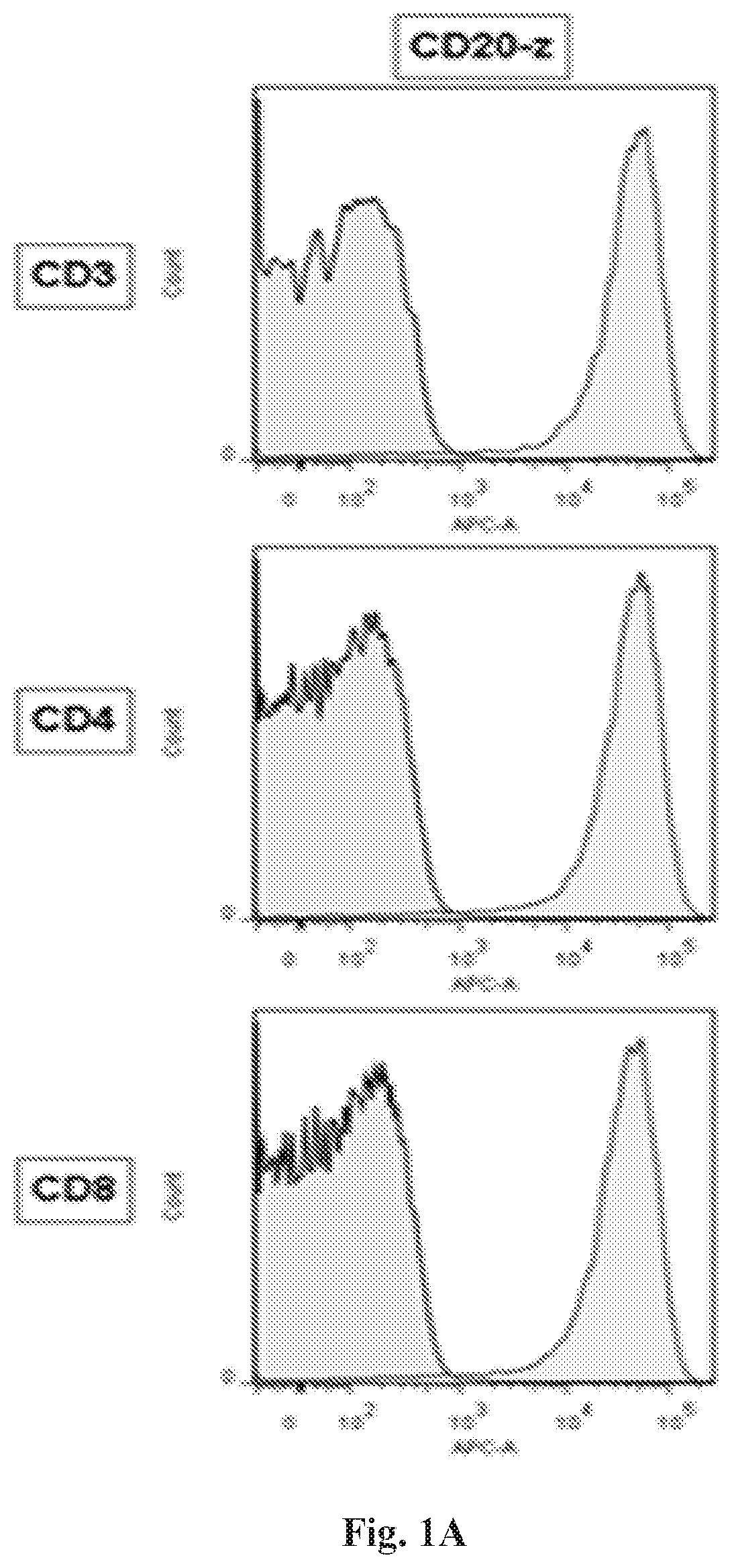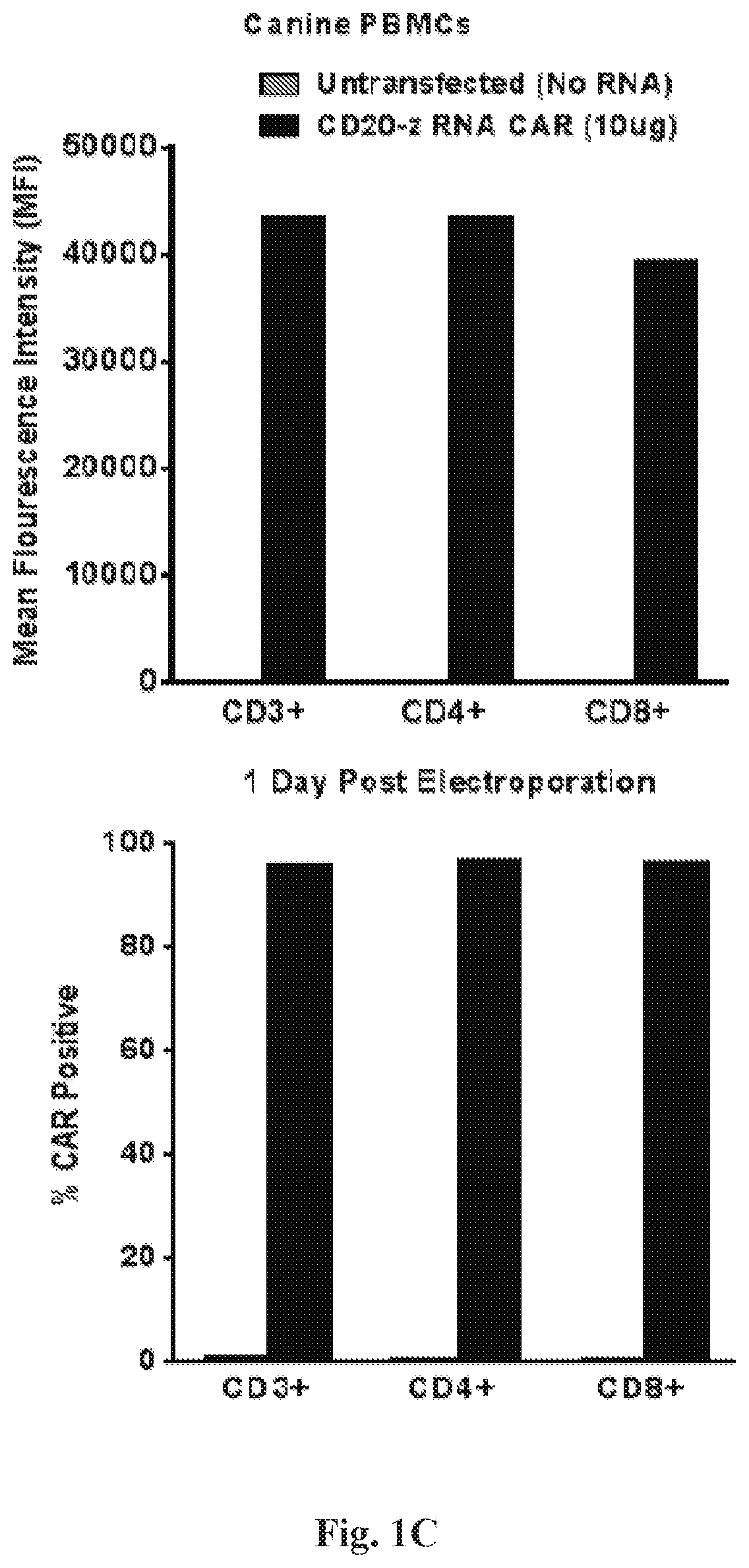Treatment of a canine cd20 positive disease or condition using a canine cd20-specific chimeric antigen receptor
a technology of chimeric antigen and canine cd20, which is applied in the direction of immunoglobulins, peptides, drugs against animals/humans, etc., can solve the problems of domestic dogs' death, short duration, and dogs' eventual death, and achieve the effect of stimulating a t cell-mediated immune respons
- Summary
- Abstract
- Description
- Claims
- Application Information
AI Technical Summary
Benefits of technology
Problems solved by technology
Method used
Image
Examples
experimental examples
[0213]The invention is further described in detail by reference to the following experimental examples. These examples are provided for purposes of illustration only, and are not intended to be limiting unless otherwise specified. Thus, the invention should in no way be construed as being limited to the following examples, but rather, should be construed to encompass any and all variations which become evident as a result of the teaching provided herein.
[0214]Without further description, it is believed that one of ordinary skill in the art can, using the preceding description and the following illustrative examples, make and utilize the compounds of the present invention and practice the claimed methods. The following working examples therefore, specifically point out exemplary embodiments of the present invention, and are not to be construed as limiting in any way for the remainder of the disclosure.
[0215]The materials and methods employed in these experiments are now described.
[02...
example 1
of CD20-Specific CAR T Cells In Vitro
[0233]CD20 is known to be a marker present on most B-cell cancers, and absent on otherwise similar appearing T-cell cancers. This feature makes CD20 particularly useful in diagnosing and / or treating conditions such as B-cell lymphomas and leukemias.
[0234]A high and persistent expression of the CD20-z CAR in CD3+, CD4+ and CD8+ human T cells and canine PBMC populations was successfully demonstrated at 24 hours (FIGS. 1A-1C) and 72 hours (FIGS. 2A-2B, FIG. 3 and FIG. 4) post electroporation. In addition, both human and canine cells showed high viability at both time points post electroporation. The tumor and engineered cell lines expressing CD20 of this invention are presented in FIGS. 5A-5B.
[0235]24 hours after co-culture, at a 1:1 ratio, of modified T cells and CD20 tumor cells, the IFNγ production by CD20-z RNA transfected canine PBMCs was measured. These results clearly showed that CD20-z RNA CAR displayed potent effector function in canine PBM...
example 2
of CD20-Specific CAR T Cell Activity In Vivo
[0240]Based on the in vitro data demonstrating that canine T cells can be genetically modified to express a CD20-specific CAR, and can proliferate and kill CD20+ target cells upon engagement of this CAR, the safety and efficacy of a lentiviral, second generation CD20-CD28-zeta CAR (SEQ ID NO: 4) in a dog with relapsed B cell lymphoma was evaluated.
[0241]A five year old, female spayed Golden Retriever previously diagnosed with B cell lymphoma was presented to the clinic. The canine patient had received standard of care chemotherapy and had achieved a short lived, clinical remission. At the time of presentation, the dog had generalized lymphadenopathy and relapse was confirmed by cytology and flow cytometry. Blood was drawn to generate an autologous CAR T cell product. The dog received a single dose of L-asparaginase at that time. After 14 days, the ex-vivo expanded T cell product (CD20-CD28-zeta, SEQ ID NO: 4) was sufficient to provide 33.4...
PUM
| Property | Measurement | Unit |
|---|---|---|
| median survival time | aaaaa | aaaaa |
| OD | aaaaa | aaaaa |
| temperature | aaaaa | aaaaa |
Abstract
Description
Claims
Application Information
 Login to View More
Login to View More - R&D
- Intellectual Property
- Life Sciences
- Materials
- Tech Scout
- Unparalleled Data Quality
- Higher Quality Content
- 60% Fewer Hallucinations
Browse by: Latest US Patents, China's latest patents, Technical Efficacy Thesaurus, Application Domain, Technology Topic, Popular Technical Reports.
© 2025 PatSnap. All rights reserved.Legal|Privacy policy|Modern Slavery Act Transparency Statement|Sitemap|About US| Contact US: help@patsnap.com



